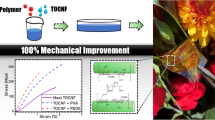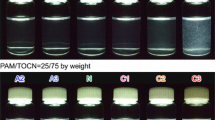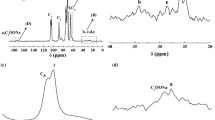Abstract
2,2,6,6-Tetramethylpiperidine-1-oxyl (TEMPO)-oxidized cellulose nanofibrils (TOCNs) and poly(acrylamide) (PAM) with sodium carboxylate groups (TOCN-COONa and PAM-COONa, respectively) were converted to TOCN and PAM with protonated carboxyl groups (TOCN-COOH and PAM-COOH, respectively). Transparent and flexible PAM-COOH/TOCN-COOH, PAM-COONa/TOCN-COOH, and PAM-COOH/TOCN-COONa composite films were prepared by mixing aqueous PAM-COOH or PAM-COONa solutions and aqueous TOCN-COOH or TOCN-COONa dispersions with various PAM/TOCN weight ratios, and successive casting/drying of the mixtures. In all cases, the Young’s modulus and tensile strength of the composite film were highest when the PAM content of the composite film was in the range 10–25 %. PAM therefore has the potential to reinforce TOCN films, irrespective of the sodium carboxylate groups or protonated carboxyl groups of TOCN or PAM. Although the FT-IR spectra of the PAM-COOH/TOCN-COOH composite films with various PAM/TOCN weight ratios indicated the formation of hydrogen bonds between PAM-COOH and TOCN-COOH, the formation of these hydrogen bonds could not explain the reinforcing effect achieved by PAM addition to TOCN-COOH. Because the TOCN elements form nematic-ordered or self-aligned domain structures in aqueous dispersions, PAM molecules at the corresponding PAM contents are probably present around the boundary regions of TOCN domains, and fill or cover the defects present between the TOCN domains.








Similar content being viewed by others
References
Chen J, Heitmann JA, Hubbe MA (2003) Dependency of polyelectrolyte complex stoichiometry on the order of addition. 1. Effect of salt concentration during streaming current titrations with strong polyacid and polybase. Colloids Surf A 223:215–230
Endo R, Saito T, Isogai A (2013) TEMPO-oxidized cellulose nanofibril/poly(vinyl alcohol) composite drawn fibers. Polymer 54:935–941
Freddi G, Tsukada M, Beretta S (1999) Structure and physical properties of silk fibroin/polyacrylamide blend films. J Appl Polym Sci 71:1563–1571
Fujisawa S, Okita Y, Fukuzumi H, Saito T, Isogai A (2011) Preparation and characterization of TEMPO-oxidized cellulose nanofibrils films with free carboxyl groups. Carbohydr Polym 84:579–583
Fukuzumi H, Saito T, Iwata T, Kumamoto Y, Isogai A (2009) Transparent and high gas barrier films of cellulose nanofibers prepared by TEMPO-mediated oxidation. Biomacromolecules 10:162–165
Fukuzumi H, Fujisawa S, Saito T, Isogai A (2013) Selective permeation of hydrogen gas using cellulose nanofibril film. Biomacromolecules 14:1705–1709
Henriksson M, Berglund LA, Isaksson P, Lindström T, Nishino T (2008) Cellulose nanopaper structures of high toughness. Biomacromolecules 9:1579–1585
Hiraoki R, Ono Y, Saito T, Isogai A (2015) Molecular mass and molecular-mass distribution of TEMPO-oxidized celluloses and TEMPO-oxidized cellulose nanofibrils. Biomacromolecules 16:675–681
Homma I, Fukuzumi H, Saito T, Isogai A (2013) Effects of carboxyl-group counter-ions on biodegradation behaviors of TEMPO-oxidized cellulose fibers and nanofibrils films. Cellulose 20:2505–2515
Isogai A (2013) Wood nanocelluloses: fundamentals and applications as new bio-based nanomaterials. J Wood Sci 59:449–459
Isogai A, Saito T, Fukuzumi H (2011) TEMPO-oxidized cellulose nanofibers. Nanoscale 3:71–85
Johnson RK, Zink-Sharp A, Renneckar SH, Glasser WG (2009) A new bio-based nanocompoiste: fibrillated TEMPO-oxidized celluloses in hydroxypropylcellulose matrix. Cellulose 16:227–238
Klemm D, Kramer F, Moritz S, Lindström T, Ankerfors M, Gray D, Dorris A (2011) Nanocelluloses: a new family of nature-based materials. Angew Chem Int Ed 50:5438–5466
Kurihara T, Isogai A (2014) Properties of poly(acrylamide)/TEMPO-oxidized cellulose nanofibril composite films. Cellulose 21:291–299
Kurihara T, Isogai A (2015) The effect of electric charge density of polyacrylamide (PAM) on properties of PAM/cellulose nanofibril composite films. Cellulose 22:499–506
Liu A, Walther A, Ikkala O, Belova L, Berglund LA (2011) Clay nanopaper with tough cellulose nanofiber matrix for fire retardancy and gas barrier functions. Biomacromolecules 12:633–641
Saito T, Kimura S, Nishiyama Y, Isogai A (2007) Cellulose nanofibers prepared by TEMPO-mediated oxidation of native cellulose. Biomacromolecules 8:2485–2491
Saito T, Uematsu T, Kimura S, Enomae T, Isogai A (2011) Self-aligned integration of native cellulose nanofibrils towards producing diverse bulk materials. Soft Matter 7:8804–8809
Sehaqui H, Liu A, Zhou Q, Berglund LA (2010) Fast preparation procedure for large, flat cellulose and cellulose/inorganic nanopaper structures. Biomacromolecules 11:2195–2198
Sehaqui H, Zhou Q, Berglund LA (2011) Nanostructured biocomposites of high toughness—a wood cellulose nanofiber network in ductile hydroxyethylcellulose matrix. Soft Matter 7:7342–7350
Shimizu M, Fukuzumi H, Saito T, Isogai A (2013) Preparation and characterization of TEMPO-oxidized cellulosenanofibrils with ammonium carboxylate groups. Int J Biol Macromol 59:99–104
Shimizu M, Saito T, Isogai A (2014a) Bulky quaternary alkylammonium counterions enhance the nanodispersibility of 2,2,6,6-tetramethylpiperidine-1-oxyl-oxidized cellulose in diverse solvents. Biomacromolecules 15:1904–1909
Shimizu M, Saito T, Fukuzumi H, Isogai A (2014b) Hydrophobic, ductile, and transparent nanocellulose films with quaternary alkylammonium carboxylates on nanofibril surfaces. Biomacromolecules 15:4320–4325
Shinoda R, Saito T, Okita Y, Isogai A (2012) Relationship between length and degree of polymerization of TEMPO-oxidized cellulose nanofibrils. Biomacromolecules 13:842–849
Smith EL, Alves CA, Anderegg JW, Porter MD, Siperko LM (1992) Deposition of metal overlayers at end-group-functionalized thiolate monolayers adsorbed at gold. 1. Surface and interfacial chemical characterization of deposited copper overlayers at carboxylic acid-terminated structures. Langmuir 8:2707–2714
Sun L, Crooks RM, Ricco AJ (1993) Molecular interactions between organized, surface-confined monolayers and vapor-phase probe molecules. 5. Acid-base interactions. Langmuir 9:1775–1780
Takahashi M, Iyoda K, Miyauchi T, Ohkido S, Tahashi M, Wakita K, Kajitani N, Kurachi M, Hotta K (2009) Preparation and characterization of Eu: Ti codoped LiNbO3 films prepared by the sol–gel method. J Appl Phys 106:044102
Wu CN, Saito T, Fujisawa S, Fukuzumi H, Isogai A (2012) Ultrastrong and high gas-barrier nanocellulose/clay-layered composites. Biomacromolecules 13:1927–1932
Wu CN, Yang Q, Takeuchi M, Saito T, Isogai A (2014) Highly tough and transparent layered composites of nanocellulose and synthetic silicate. Nanoscale 6:392–399
Yan F, Zheng C, Zhai X, Zhao D (1998) Preparation and characterization of polyacrylamide in cationic microemulsion. J Appl Polym Sci 67:747–754
Acknowledgments
This research was supported by Core Research for Evolutional Science and Technology (CREST) of the Japan Science and Technology Agency (JST).
Author information
Authors and Affiliations
Corresponding author
Rights and permissions
About this article
Cite this article
Kurihara, T., Isogai, A. Mechanism of TEMPO-oxidized cellulose nanofibril film reinforcement with poly(acrylamide). Cellulose 22, 2607–2617 (2015). https://doi.org/10.1007/s10570-015-0680-5
Received:
Accepted:
Published:
Issue Date:
DOI: https://doi.org/10.1007/s10570-015-0680-5




